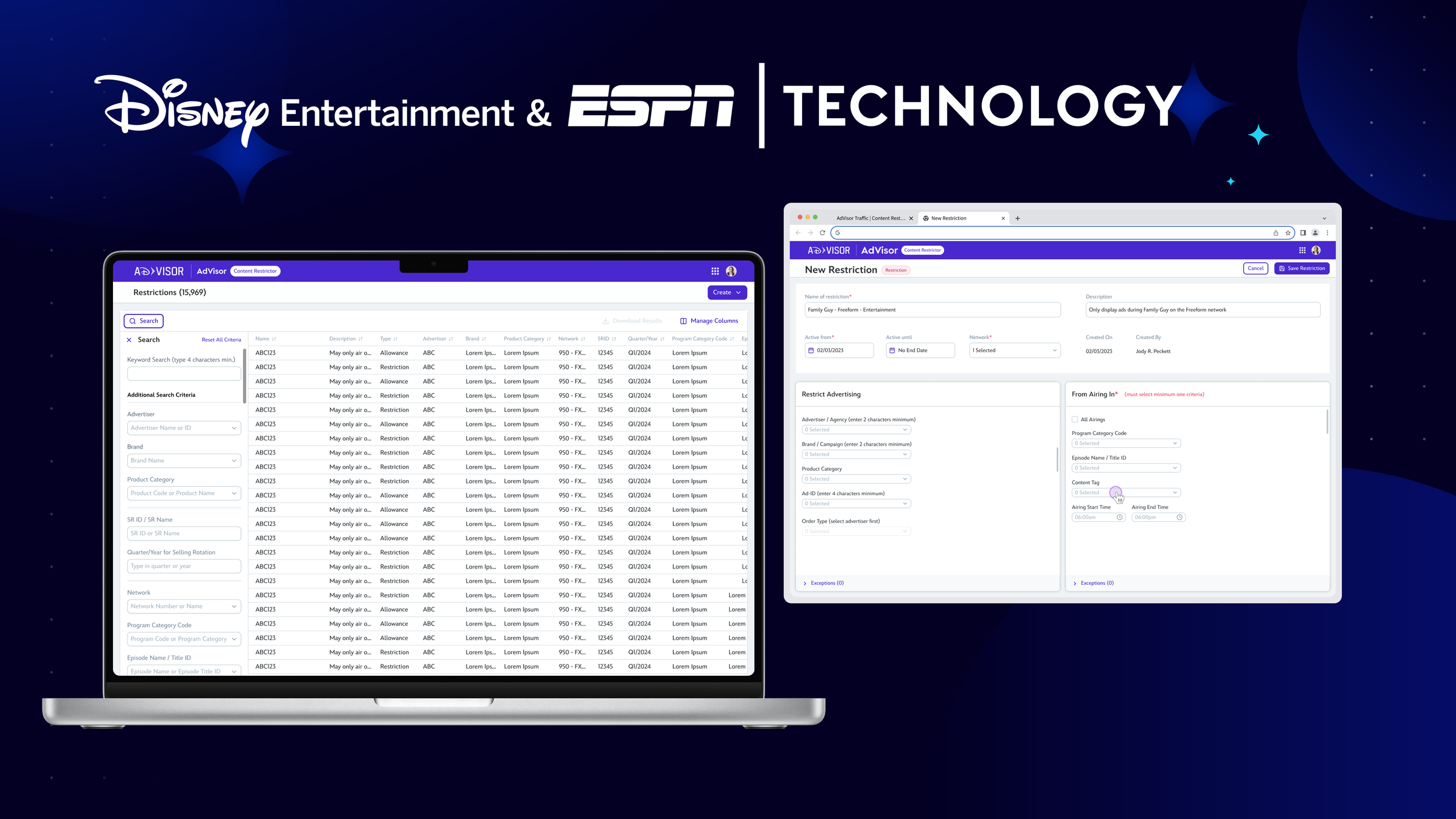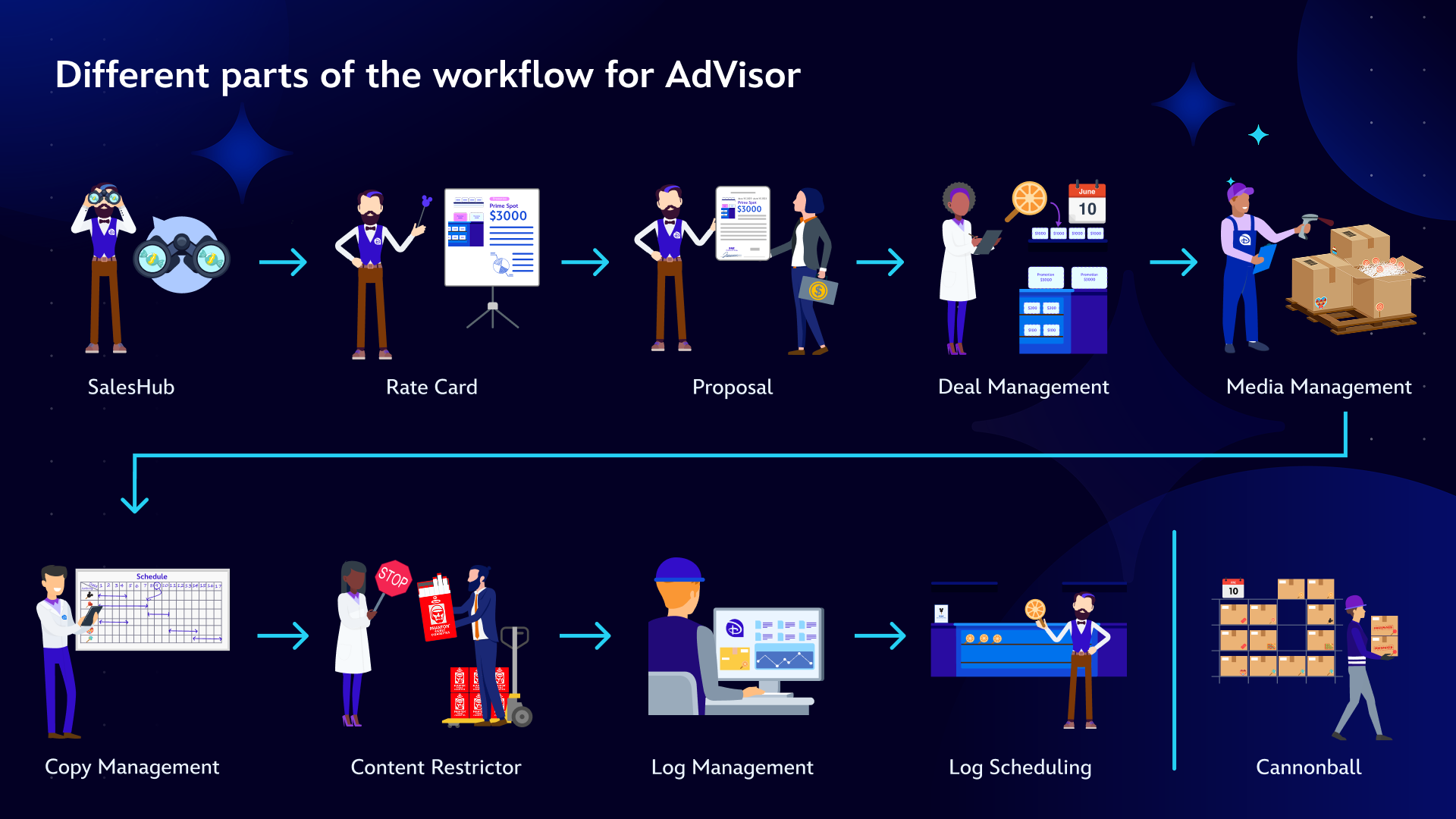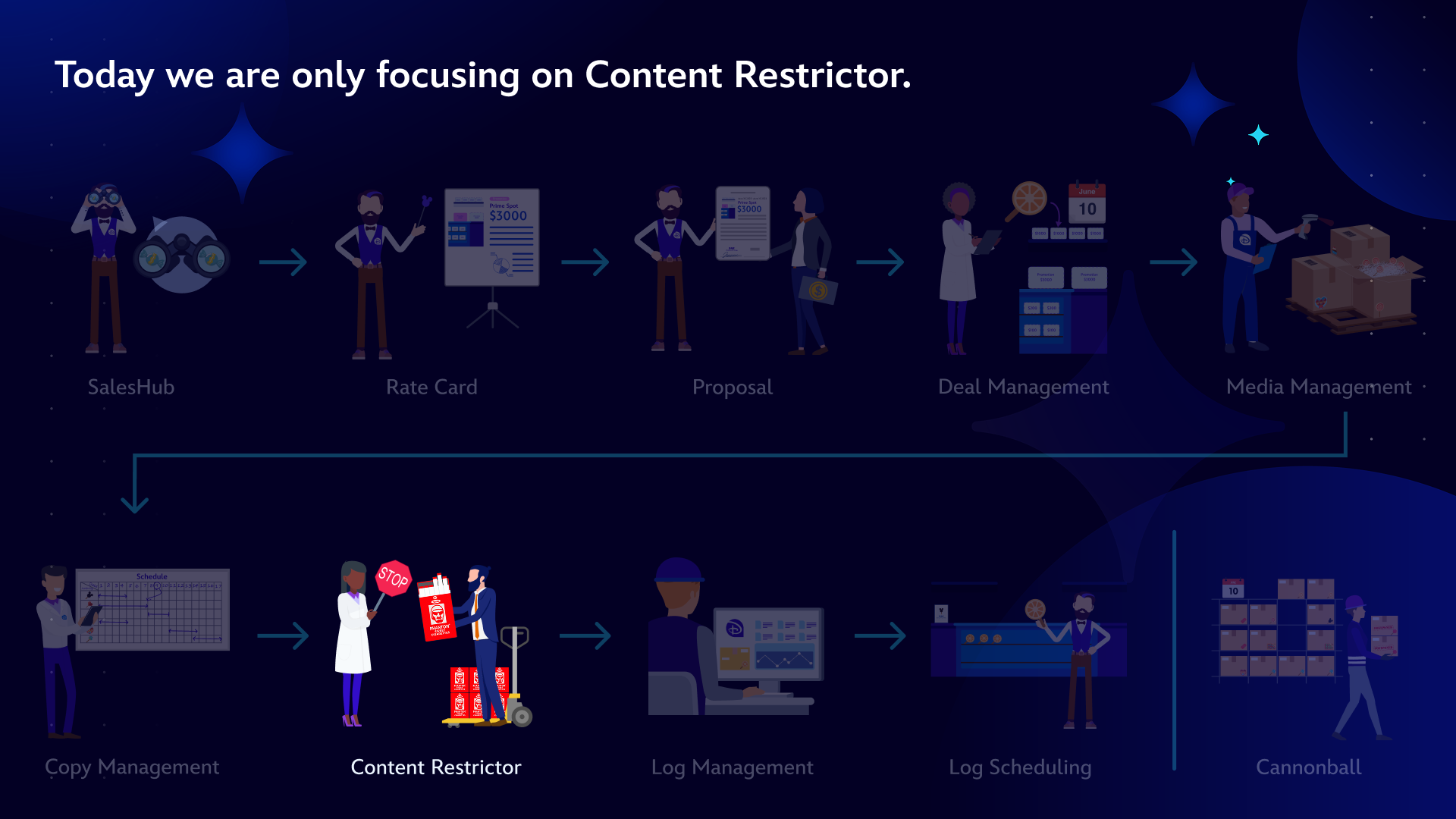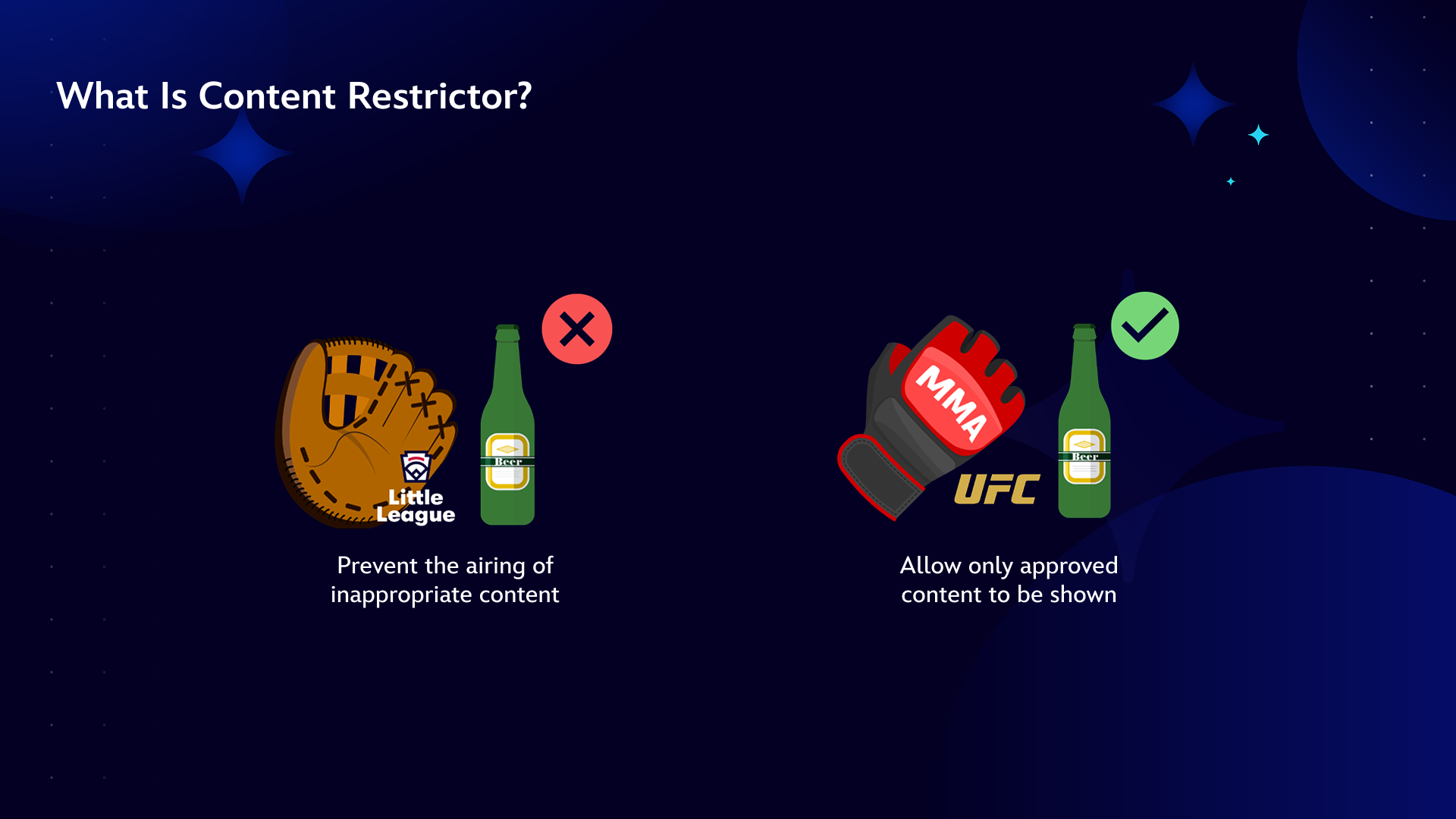Modernizing & streamlining an enterprise tool for Disney+ advertising distribution programming
Role: Lead Product Designer
Skills utilized: Product strategy and UX architecture; wireframing, prototyping, and high-fidelity mockups; research synthesis and visual design; presenting solutions in stakeholder workshops; cross-functional collaboration and alignment
Supporting Team: Scrum Master, product owner, technical product manager, several front-end engineers, several back-end engineers, & a few QA engineers
Tools & Methods: Figma · FigJam · Jira · Confluence · Airtable · User Interviews · A/B Testing · Information Architecture · Interaction Design
Primary Users: Designers, Content Strategists, Developers, project managers, and business partners across Allstate’s enterprise teams
What is Content Restrictor?
Content Restrictor is an enterprise application that’s a segment of a broader suite of workflow apps called AdVisor, that helps programming content managers to create rules that prevent certain ads from airing during certain TV programs.
There are two types of restrictions: restriction & allowances.
Restrictions are rules set up to constrict advertising in certain programs.
Allowances are another new restriction type that is easier for the user to define what is allowed, as opposed to what is not allowed.
Both work in conjunction to help prevent ads from airing where they shouldn’t.
The Challenge
Disney Entertainment & ESPN Technology oversees a massive network of ad delivery systems across Disney+ and linear channels. One of their critical internal tools – Content Restrictor – governed the complex rules that prevent certain ads from airing during specific programs.
Over time, this enterprise tool had become fragmented across multiple databases and outdated UIs. Programming and distribution teams struggled with inefficiencies, data inconsistencies, and error-prone workflows when managing restrictions and allowances for global ad delivery.
The business need was clear: modernize the experience to be faster, more intuitive, and scalable — without sacrificing precision or compliance.
Task
As the Lead Product Designer, my challenge was to reimagine the Content Restrictor experience as part of the broader AdVisor ecosystem — a suite of workflow applications for Disney’s advertising operations.
Our Main Objectives
Consolidate three disparate databases into one unified platform
Modernize the search and restriction workflows, improving speed and clarity
Introduce a new “Allowance” feature, enabling users to define what can air (the inverse of restrictions)
Reduce redundancy, simplify data entry, and create a more intuitive architecture for rule creation and management
All of this had to be accomplished within tight timelines, while working around legacy system constraints and coordinating across multiple departments.
Action
1. Discovery & Research
I began by conducting user interviews with programming managers and distribution operations executives — the tool’s primary users. These sessions revealed major inefficiencies:
Users were toggling between three separate systems to verify restrictions.
Searches were slow and non-intuitive.
Many relied on manual notes to recall previous configurations.
To quantify these findings, I ran A/B tests and workflow time studies, benchmarking the old vs. proposed designs.
2. Defining the Architecture
From there, I developed IA diagrams and structural maps to clarify how restrictions and allowances should relate to ads, programs, and networks.
This new model became the backbone for:
Persistent data states across tabs and pages
Default and user-saved views (using session ID persistence)
Clear categorization between “restriction” and “allowance” types
This approach simplified mental models and reduced misclassification errors during ad scheduling.
3. Designing for Efficiency
Working in Figma and FigJam, I redesigned several critical components:
Search Page Modernization — introduced keyword + multi-criteria search, inline previews, and on-page column management.
Restriction Details Page — reorganized fields based on frequency of use and added contextual cues for time, network, and advertiser validation.
Allowance Page — designed a complementary feature to handle permitted content, using mirrored logic for consistency.
Multi-Select Input — built a nested, scalable component from Disney’s design system to handle complex region and category selections efficiently.
Each design underwent rapid iteration, with stakeholder workshops to validate flows and ensure technical feasibility.
4. Collaboration & Handoff
Throughout, I collaborated daily with:
Product Owner and Technical PM to align on prioritization
Engineers to test component scalability and performance
QA to define test cases and validation criteria
We ran several feedback cycles and iterated prototypes across multiple design sprints before handing off the final UI package.
Result
The redesigned Content Restrictor delivered measurable, organization-wide impact:
Efficiency Gains - Enhanced workflow speed by 75% end-to-end
Data Accuracy - Reduced user error rate by 40%
Consolidation - Unified 3 separate databases into a single system
Retrieval Time - Cut data lookup time by 60%
Task Completion - Reduced ad-rule creation from 15–20 min → under 5 min
User Experience - Improved readability, information hierarchy, and ease of use
The result was not just a faster tool — it was a smarter system that helped Disney’s programming managers ensure brand safety, compliance, and speed at global scale.
Scope & Constraints -
Tight deadlines and evolving priorities
Legacy system dependencies
Cross-department alignment (Engineering, Ad Ops, and Legal)
Balancing data persistence with real-time interactivity
Key Learnings
This project reinforced the value of designing for clarity and control within enterprise systems. By focusing on structure, feedback, and consistency, I was able to elevate a legacy workflow into a modern, scalable platform that empowered users — not slowed them down.
It also underscored the importance of cross-functional empathy: designing not just for users, but with engineers, PMs, and QA to achieve a shared vision.
Impact Summary
✅ Modernized a legacy enterprise tool
✅ Improved efficiency by 75–80%
✅ Reduced error rate by 40%
✅ Consolidated multiple databases into one unified experience
✅ Established foundation for future AdVisor features












